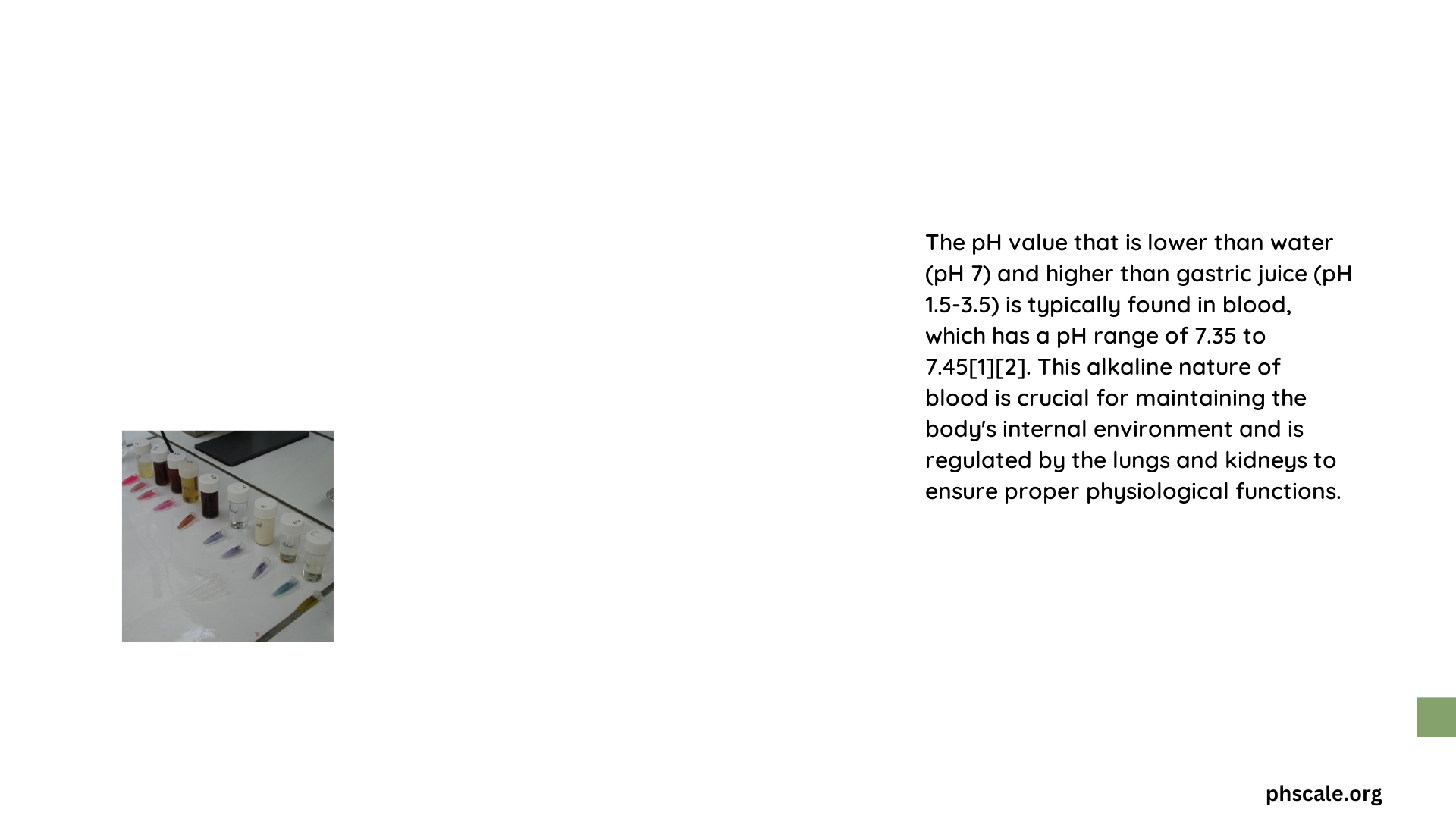Solutions with pH levels between pure water (pH 7) and gastric juice (pH 1.5-3.5) are acidic but less extreme than stomach acid. This range includes common substances like vinegar, citrus juices, and soft drinks. These solutions play important roles in cooking, cleaning, and various industrial processes. Understanding their properties and effects is crucial for applications in food science, chemistry, and biology.
What is the pH range between water and gastric juice?
The pH range between water (pH 7) and gastric juice (pH 1.5-3.5) spans from approximately 3.5 to 7. This range encompasses a variety of common substances and solutions:
- Vinegar: pH 2-3
- Lemon juice: pH 2-3
- Soft drinks: pH 2.5-4
- Orange juice: pH 3.3-4.2
- Tomato juice: pH 4-4.5
- Black coffee: pH 5-5.5
- Milk: pH 6.5-6.7
What are the chemical compositions of solutions in this pH range?

The chemical compositions of solutions with pH lower than water but higher than gastric juice vary depending on the specific substance:
- Vinegar: Primarily acetic acid (CH3COOH) in water
- Citrus juices: Contain citric acid (C6H8O7) and other organic acids
- Soft drinks: Often include phosphoric acid (H3PO4) or citric acid
- Coffee: Contains various organic acids, including chlorogenic acid
These acidic compounds contribute to the lower pH of these solutions compared to pure water.
How do these pH levels affect biological systems?
The pH levels between water and gastric juice can have various effects on biological systems:
- Tooth enamel erosion: Frequent exposure to acidic beverages can lead to dental problems
- Digestive system: Mild acids can stimulate digestion, but excessive consumption may cause irritation
- Skin and mucous membranes: Direct contact with more acidic solutions can cause irritation or damage
- Cellular function: pH levels affect enzyme activity and protein structure within cells
It’s important to note that the human body has buffering systems to maintain optimal pH levels in different tissues and organs.
What are the practical applications of solutions in this pH range?
Solutions with pH lower than water but higher than gastric juice have numerous practical applications:
- Food and beverage industry:
- Flavor enhancement
- Preservation
-
pH adjustment in recipes
-
Cleaning and household use:
- Removing mineral deposits
- Disinfecting surfaces
-
Fabric softening (vinegar)
-
Industrial processes:
- Metal cleaning and etching
-
pH adjustment in manufacturing
-
Agriculture:
- Soil pH adjustment
-
Nutrient solutions for hydroponics
-
Personal care products:
- Hair care (vinegar rinses)
- Skin toners
How do these pH levels compare to gastric juice in terms of acidity?
To understand the relative acidity of solutions between water and gastric juice, let’s compare their pH levels:
| Solution | pH Range | Relative Acidity |
|---|---|---|
| Gastric juice | 1.5-3.5 | Highest |
| Vinegar | 2-3 | Very high |
| Lemon juice | 2-3 | Very high |
| Soft drinks | 2.5-4 | High |
| Orange juice | 3.3-4.2 | Moderate |
| Black coffee | 5-5.5 | Low |
| Milk | 6.5-6.7 | Very low |
| Water | 7 | Neutral |
As we move down the table, the acidity decreases, with gastric juice being the most acidic and water being neutral.
What methods are used to measure pH in this range?
Several methods are employed to measure pH levels between water and gastric juice:
- pH meters:
- Most accurate method
- Uses a glass electrode sensitive to hydrogen ions
-
Requires regular calibration
-
pH indicator strips:
- Quick and easy to use
- Less accurate than pH meters
-
Color-coded for different pH ranges
-
Colorimetric methods:
- Uses chemical indicators that change color based on pH
-
Examples include phenol red and bromothymol blue
-
Titration:
- More time-consuming but highly accurate
- Involves adding a known base to the acidic solution until neutralization
For solutions in this pH range, pH meters and indicator strips are most commonly used due to their convenience and reliability.
How do these pH levels affect chemical reactions?
The pH levels between water and gastric juice can significantly influence chemical reactions:
- Reaction rates:
- Many reactions proceed faster in acidic conditions
-
Acid catalysis is important in organic chemistry
-
Equilibrium shifts:
-
pH changes can shift chemical equilibria according to Le Chatelier’s principle
-
Solubility:
- Some compounds are more soluble in acidic solutions
-
Others may precipitate as pH decreases
-
Corrosion:
-
Acidic solutions can accelerate corrosion of metals
-
Enzyme activity:
- Many enzymes have optimal pH ranges for maximum activity
- pH levels in this range can affect enzyme-catalyzed reactions
Understanding these effects is crucial for controlling chemical processes in various industries and applications.
What safety precautions should be taken when handling solutions in this pH range?
When working with solutions that have pH lower than water but higher than gastric juice, several safety precautions should be observed:
- Personal protective equipment (PPE):
- Wear gloves, safety goggles, and appropriate clothing
-
Use a lab coat or apron for additional protection
-
Ventilation:
-
Work in a well-ventilated area or under a fume hood if necessary
-
Handling and storage:
- Use appropriate containers resistant to acid corrosion
-
Label containers clearly and store them properly
-
Spill management:
- Have neutralizing agents (e.g., sodium bicarbonate) available
-
Follow proper spill cleanup procedures
-
First aid:
- Know the location of eyewash stations and safety showers
-
Flush affected areas with water if contact occurs
-
Training:
- Ensure proper training for handling acidic solutions
- Familiarize yourself with safety data sheets (SDS) for specific chemicals
By following these precautions, you can minimize risks associated with handling mildly acidic solutions.
References:
1. BYJU’S – pH Chemistry (Acids & Bases)
2. Mometrix – pH Overview (Video & FAQ)
3. Wikipedia – pH
